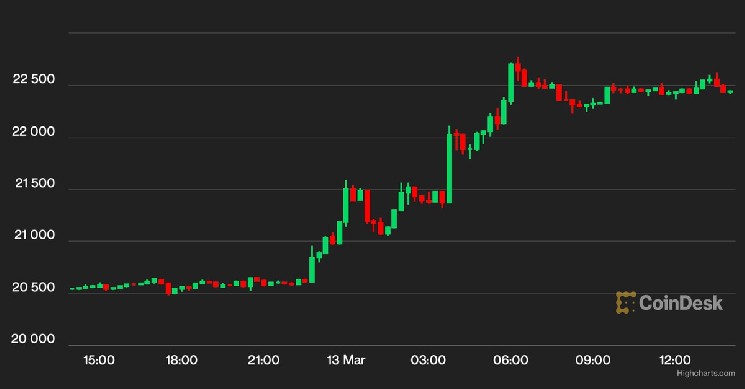Silicon Valley Bank Crisis a ‘Cyprus Moment’ for Bitcoin: Crypto Observers

The collapse of Silicon Valley Bank (SVB) is a blessing for bitcoin (BTC), crypto observers said, drawing parallels with the 2013 Crypus crisis that underscored flaws in the fractional reserve system and brought attention to decentralized, censorship-resistant BTC as a hedge against centralized banking.
«Silicon Valley Bank, the 18th largest bank in the nation, collapsed yesterday—with it, we learn how last year’s record selloff in U.S. Treasuries has created billions of dollars worth of unrealized losses within the banking sector and gain yet another example that in a system of fractional reserve banking, there are no depositors, only lenders,» Researcher Nik Bhatia and market analyst Joe Consorti said in the latest edition of The Bitcoin Layer newsletter.
«The Fed’s aggressive rate hikes and balance sheet reduction have caused a historic bank failure — fashioning a real-time ad for Bitcoin self-custody,» Bhatia and Consorti added.
The crisis at SVB began early last week after the startups-focused bank sold a portfolio consisting primarily of U.S. treasuries or government bonds at a loss and announced a share sale to shore up its balance sheet. Prices of Treasury notes have tanked over the past year thanks to the Federal Reserve’s (Fed) aggressive rate hike campaign to control inflation. (Bond prices and yields move in the opposite direction).
What followed was a good old-fashioned bank run as SVB depositors scrambled to withdraw funds, with the total deposit call reaching $42 billion on Wednesday – nearly 25% of the total deposit base of $173 billion.
Bank runs happen because fractional reserve banking requires lenders to maintain only a small portion of deposits available for withdrawal while the rest are lent out to fuel economic activity. The system assumes that at any given point, withdrawal demand will not exceed the pain threshold. The assumption, however, goes up in smoke when customer confidence tanks, as it did in SVB’s case, leading to a spike in withdrawals and liquidity shortage at the bank.
Regulators usually step in after bank runs, seizing or taking control of deposits. The solution to the 2013 Cyprus banking crisis actually involved regulators raiding customer accounts. Germany coughed up around $13 billion in exchange for Cyprus levying a one-time tax on bank deposits to raise an additional $7.5 billion to complete the banking sector bailout.
In SVB’s case, U.S. regulators took control of the deposits and shut down the bank on Friday. Over the weekend, the Biden administration announced that all SVB depositors could access their funds starting Monday. The announcement came as another New York-based lender, Signature Bank (SBNY), also failed, a sign of fast-spreading panic in the banking sector.
Though measures taken to address the SVB crisis aren’t as draconian as the one taken for Cyprus, the entire episode underscores the point that customers’ funds aren’t as safe in regulated banks as we are made to believe. This point validated bitcoin’s appeal as a decentralized peer-to-peer network and seizure-resistant cryptocurrency facilitating self-custody of funds.
«Not your keys, not your coins’ is a lesson that, apparently, has to be learned again and again as history finds ways to repeat,» Mike Fay, Author of Blockchain Reaction, said in the latest article at Seeking Alpha, discussing investor takeaway from the collapse of SVB and Silvergate Capital and the 2013 Cyprus banking crisis.
«It’s very easy to sit comfortably in the western world with the perception of safe and regulated banking institutions and not understand why anyone would feel compelled to purchase assets that live outside that world. But history shows that banks are capable of making bad bets or bad decisions,» Fay added.
Bitcoin surged during Cyprus crisis
Bitcoin rallied sharply as the Cyprus banking crisis unfolded in March of 2013. The cryptocurrency surged 178% to $93 that month and hit a record high of $265 in May of 2013. Back then, there were reports of euro and Russian rouble holders diversifying into bitcoin after seeing bank shutdowns in Cyprus.
«Ten years ago this week, there was a bank run in Cyprus, where ATMs were emptied and vaults were depleted. This event triggered the largest-ever rally (in percentage terms) in BTC, which rallied from $45 to $260 in a month,» crypto trading giant Cumberland tweeted early Monday.
Coincidentally, bitcoin has risen over 15% since Friday, rising from two-month lows near $19,500 to $22,500, CoinDesk data show.
«When traders are unsure about crypto prices, they flee to stablecoins and bank deposits. When they are unsure about stables and bank deposits? It’s crypto’s time to shine, and BTC and ETH rallied 14 and 15%, respectively, over the weekend amidst uncertainty in the banking sector,» Cumberland noted.
«History doesn’t always repeat itself, but it often rhymes,» Cumberland added.






 Bitcoin
Bitcoin  Ethereum
Ethereum  Tether
Tether  USDC
USDC  Dogecoin
Dogecoin  Cardano
Cardano  TRON
TRON  Chainlink
Chainlink  Stellar
Stellar  Hedera
Hedera  Bitcoin Cash
Bitcoin Cash  LEO Token
LEO Token  Litecoin
Litecoin  Monero
Monero  Dai
Dai  OKB
OKB  Ethereum Classic
Ethereum Classic  Cronos
Cronos  Gate
Gate  VeChain
VeChain  Cosmos Hub
Cosmos Hub  Algorand
Algorand  Stacks
Stacks  Maker
Maker  KuCoin
KuCoin  Theta Network
Theta Network  Tether Gold
Tether Gold  IOTA
IOTA  Tezos
Tezos  Zcash
Zcash  TrueUSD
TrueUSD  NEO
NEO  Polygon
Polygon  Dash
Dash  Synthetix Network
Synthetix Network  Zilliqa
Zilliqa  Qtum
Qtum  0x Protocol
0x Protocol  Decred
Decred  Basic Attention
Basic Attention  Siacoin
Siacoin  Holo
Holo  Ravencoin
Ravencoin  DigiByte
DigiByte  Enjin Coin
Enjin Coin  NEM
NEM  Ontology
Ontology  Nano
Nano  Hive
Hive  Waves
Waves  Lisk
Lisk  Status
Status  Steem
Steem  Numeraire
Numeraire  Pax Dollar
Pax Dollar  BUSD
BUSD  Huobi
Huobi  OMG Network
OMG Network  Bitcoin Gold
Bitcoin Gold  Ren
Ren  Augur
Augur  Bitcoin Diamond
Bitcoin Diamond  HUSD
HUSD